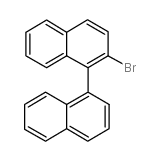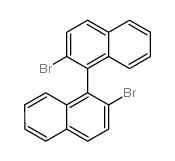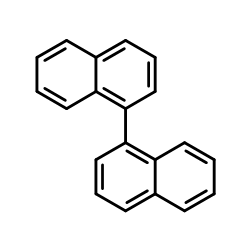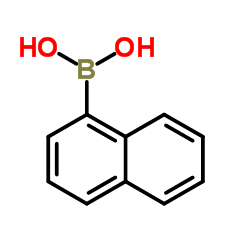207611-58-3
| Name | 2-bromo-1,1-binaphthyl |
|---|---|
| Synonyms |
2-Bromo-1,10-phenathroline
2-bromo-1,1'-binaphthyl 2-bromo-1,1'-binaphtyl 2-Bromo-1,10-phenant |
| Density | 1.393g/cm3 |
|---|---|
| Boiling Point | 435.2ºC at 760 mmHg |
| Molecular Formula | C20H13Br |
| Molecular Weight | 333.22100 |
| Flash Point | 212.2ºC |
| Exact Mass | 332.02000 |
| LogP | 6.42250 |
| Vapour Pressure | 2.27E-07mmHg at 25°C |
| Index of Refraction | 1.717 |
|
Section 1: Product Identification Chemical Name:2-Bromo-1,1'-binaphthyl, 98% CAS Registry Number:207611-58-3 Formula:C20H13Br EINECS Number:none Chemical Family:organic bromide Synonym:none
Section 2: Composition and Information on Ingredients IngredientCAS NumberPercentACGIH (TWA)OSHA (PEL) Title compound207611-58-3100%no datano data Section 3: Hazards Identification Emergency Overview:Irritating to skin, eyes and respiratory tract. Primary Routes of Exposure:Ingestion, inhalation Eye Contact:Causes slight to mild irritation of the eyes. Skin Contact:Causes slight to mild irritation of the skin. Inhalation:Irritating to the nose, mucous membranes and respiratory tract. Ingestion:No information available on the physiological effects of ingestion. May be harmful if swallowed. Acute Health Affects:Irritating to skin, eyes and respiratory tract. Chronic Health Affects:No information on long-term chronic effects. NTP:No IARC:No OSHA:No SECTION 4: First Aid Measures Immediately flush the eyes with copious amounts of water for at least 10-15 minutes. A victim may need Eye Exposure: assistance in keeping their eye lids open. Get immediate medical attention. Wash the affected area with water. Remove contaminated clothes if necessary. Seek medical assistance if Skin Exposure: irritation persists. Remove the victim to fresh air. Closely monitor the victim for signs of respiratory problems, such as difficulty Inhalation: in breathing, coughing, wheezing, or pain. In such cases seek immediate medical assistance. Seek medical attention immediately. Keep the victim calm. Give the victim water (only if conscious). Induce Ingestion: vomiting only if directed by medical personnel. SECTION 5: Fire Fighting Measures Flash Point:no data Autoignition Temperature:no data Explosion Limits:no data Extinguishing Medium:carbon dioxide, dry powder or foam If this product is involved in a fire, fire fighters should be equipped with a NIOSH approved positive pressure Special Fire Fighting Procedures: self-contained breathing apparatus and full protective clothing. Hazardous Combustion andIf involved in a fire this material may emit irritating fumes of hydrogen bromide Decomposion Products: Unusual Fire or Explosion Hazards: No unususal fire or explosion hazards. SECTION 6: Accidental Release Measures Spill and Leak Procedures:Small spills can be mixed with vermiculite or sodium carbonate and swept up. SECTION 7: Handling and Storage Handling and Storage:Store in a tightly sealed container. Keep in a cool, dry, well ventilated place. SECTION 8: Exposure Controls and Personal Protection Eye Protection:Always wear approved safety glasses when handling a chemical substance in the laboratory. Skin Protection:Wear protective clothing and gloves. Ventilation:Handle the material in an efficient fume hood. If ventilation is not available a respirator should be worn. The use of respirators requires a Respirator Respirator: Protection Program to be in compliance with 29 CFR 1910.134. Ventilation:Handle the material in an efficient fume hood. Additional Protection:No additional protection required. SECTION 9: Physical and Chemical Properties Color and Form:white powder Molecular Weight:333.22 Melting Point:no data Boiling Point:no data Vapor Pressure:no data Specific Gravity:no data Odor:none Solubility in Water:insoluble SECTION 10: Stability and Reactivity Stability:air and moisture stable Hazardous Polymerization:no hazardous polymerization Conditions to Avoid:none Incompatibility:active metals, oxidizing agents and halogens Decomposition Products:carbon monoxide, carbon dioxide, organic fumes and hydrogen bromide SECTION 11: Toxicological Information RTECS Data:No information available in the RTECS files. Carcinogenic Effects:no data Mutagenic Effects:no data Tetratogenic Effects:no data SECTION 12: Ecological Information Ecological Information:No information available SECTION 13: Disposal Considerations Disposal:Dispose of according to local, state and federal regulations. SECTION 14: Transportation Shipping Name (CFR):Non-hazardous Hazard Class (CFR):NA Additional Hazard Class (CFR):NA Packaging Group (CFR):NA UN ID Number (CFR):NA Shipping Name (IATA):Non-hazardous Hazard Class (IATA):NA Additional Hazard Class (IATA):NA Packaging Group (IATA):NA UN ID Number (IATA):NA SECTION 15: Regulatory Information TSCA:Not listed in the TSCA inventory SARA (Title 313):Title compound not listed Second Ingredient:none SECTION 16 - ADDITIONAL INFORMATION N/A |
|
~94% 
207611-58-3 |
| Literature: Wang, Yahui; McGonigal, Paul R.; Herle, Bart; Besora, Maria; Echavarren, Antonio M. Journal of the American Chemical Society, 2014 , vol. 136, # 2 p. 801 - 809 |
|
~86% 
207611-58-3 |
| Literature: Nagaki, Aiichiro; Takabayashi, Naofumi; Tomida, Yutaka; Yoshida, Jun-ichi Organic Letters, 2008 , vol. 10, # 18 p. 3937 - 3940 |
|
~% 
207611-58-3 |
| Literature: Zhang, Heng; Hu, Rong-Bin; Zhang, Xiao-Yu; Li, Shi-Xia; Yang, Shang-Dong Chemical Communications, 2014 , vol. 50, # 36 p. 4686 - 4689 |
|
~% 
207611-58-3 |
| Literature: Clayden, Jonathan; Kubinski, Przemyslaw M.; Sammiceli, Federica; Helliwell, Madeleine; Diorazio, Louis Tetrahedron, 2004 , vol. 60, # 20 p. 4387 - 4397 |




